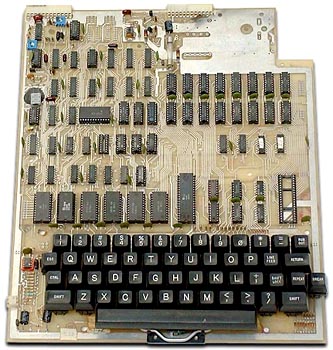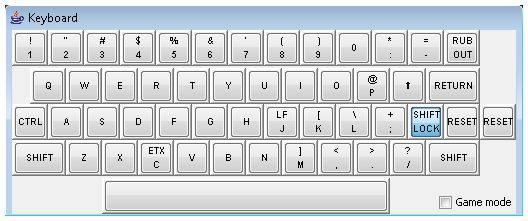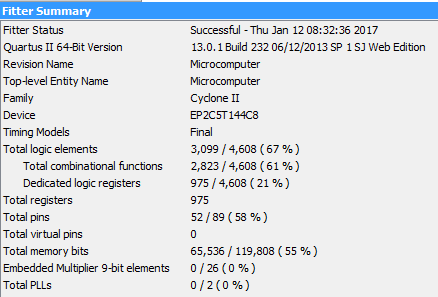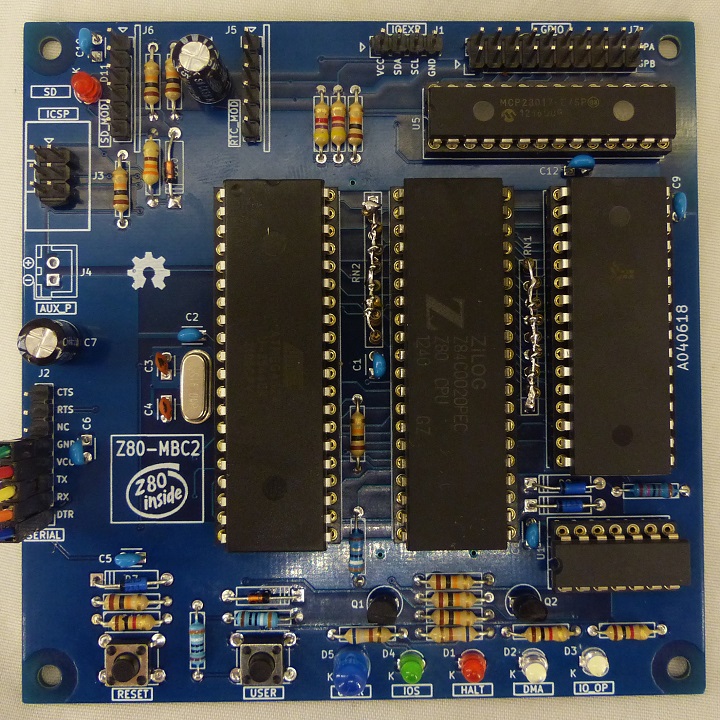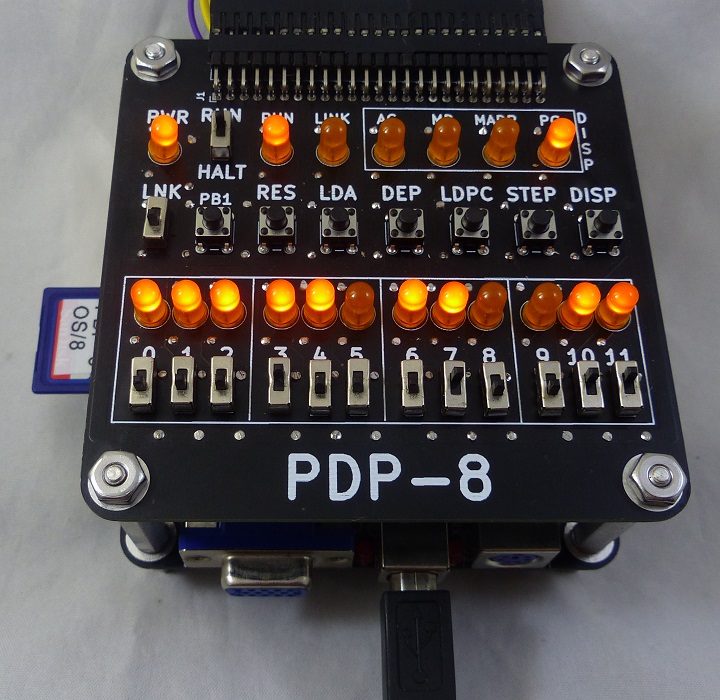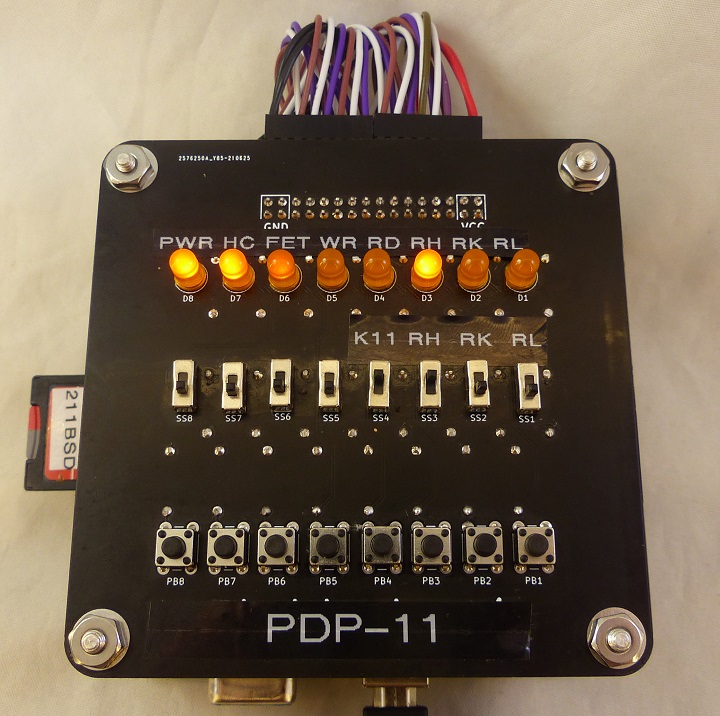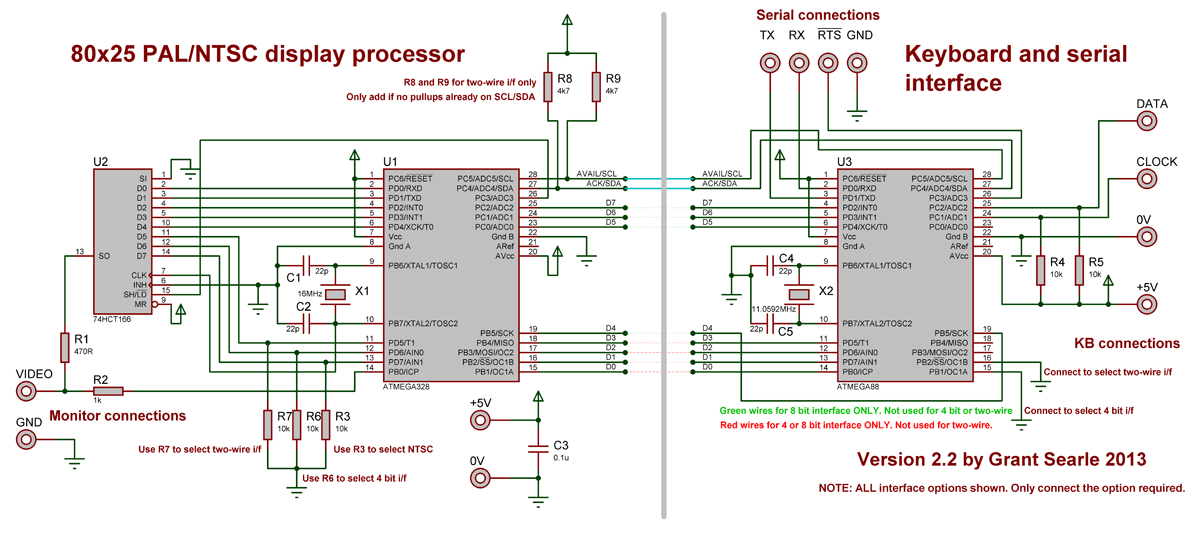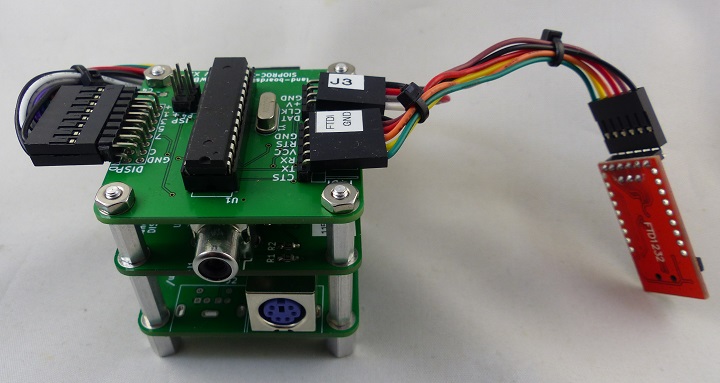Difference between revisions of "RetroComputers"
Blwikiadmin (talk | contribs) |
Blwikiadmin (talk | contribs) |
||
| Line 29: | Line 29: | ||
=== My First Computer Build === | === My First Computer Build === | ||
| − | My first attempt | + | My first attempt was way back in 1977 (before my Ohio Scientific SuperBoard II). I built a homebrewed computer around an MC6800 CPU so the CPU has a soft spot in my heart. I never took any pictures of it and the hardware is long gone now. These are the pieces of it I remember. |
* Elco? 120 pin edge connector wire wrapped cards | * Elco? 120 pin edge connector wire wrapped cards | ||
Revision as of 15:49, 22 April 2022
Contents
- 1 Grant Searle's FPGA MultiComp Project
- 2 6800 CPU
- 3 6502 CPU
- 4 6809 CPU
- 5 Z80 CPU
- 6 68000 CPU
- 6.1 TG68_AMR Design
- 6.2 TeeSide 2 design with Multicomp parts
- 6.2.1 TeeSide 2 Memory Map
- 6.2.2 TeeSide 2 Monitor ROMs
- 6.2.3 TeeSide 2 Build on RETRO-EP4CE15 Running TS2 Monitor
- 6.2.4 TeeSide 2 Build on RETRO-EP4CE15 Running TUTOR Monitor
- 6.2.5 TeeSide 2 Build on Cyclone V Running TS2 Monitor
- 6.2.6 TeeSide 2 Build on Cyclone V in Box Running TS2 Monitor
- 6.2.7 TeeSide 2 Software
- 6.2.8 TeeSide 2 Links
- 6.3 68000 Software
- 6.4 Other People's 68000 Builds
- 7 DEC (Digital Equipment Corp) Computers
- 8 RISC V CPU
- 9 Terminal
- 10 External Sites
Grant Searle's FPGA MultiComp Project
FPGA Recreations of 6502, 6809, and Z80 Vintage Computers
- Multicomp on Land Boards Cards - Hardware
- Multicomp on Purchased Cards
- FPGA Support Cards
- MultiComp Wiki Page on GitHub
- Multicomp Github repo
Our MultiComp Retro-Computer Video Series
Cyclone II Video Series
Cyclone IV Video Series
6800 CPU
My First Computer Build
My first attempt was way back in 1977 (before my Ohio Scientific SuperBoard II). I built a homebrewed computer around an MC6800 CPU so the CPU has a soft spot in my heart. I never took any pictures of it and the hardware is long gone now. These are the pieces of it I remember.
- Elco? 120 pin edge connector wire wrapped cards
- 6800 Processor board running at 1 MHz
- 2K of Static RAM board
- 2716 EEPROM board (may have had 4 sockets total, don't recall for sure)
- Front panel switches and LEDs to enter the address/data and blink lights
I remember getting it to run and I do remember blinking a light back and forth on it. Once I got the SuperBoard II, I stopped working on my own board.
It might be fun to reproduce that board!
6800 MIKBUG - Builds
This build fills a hole in Grant Searle's Multicomp (he hadn't finished a 6800 version). It also completes the project I started back in 1977 with a lot of built-in features I could never have imagined back in the day.
- MC6800 CPU
- Two versions of MIKBUG from back in the day (actually, running SmithBug ACIA version)
- 25 MHz
- SRAM options
- 32KB (Internal) SRAM version (requires EP4CE15 minimum)
- 60K (external) RAM version
- 60K RAM version (requires Cyclone V FPGA)
- MC6850 ACIA UART
- Video Display Unit (VDU)
- Color attributes
- XGA 80x25 ANSI character display
- Extended (256) character set
- PS/2 keyboard
- Runs Tom Pittman's Tiny BASIC
- Build on EP4CE15 card
- Build on EP2C5 card
- Build on EP4CE10 card
- Build on EP4CE6 card
- Build on EP4CE15 Starter Kit card
- Build on EP4CE6 card (RETRO-EP4)
- Build on EP4CE6 card (RETRO-EP4) 60KB SRAM
- Build on EP4CE15 card
- Build on EP4CE15 card 60KB SRAM, 1MB Banked SRAM
- Build on EP4CE15 card Front Panel control
- Build on Cyclone V card 60KB SRAM, 1MB Banked SRAM
Memory Map (60KB SRAM version)
- $0000-$EFFF - 60KB external sRAM
- $0000-$EEFF - User RAM area
- $EF00-$EFFF - scratchpad used by MIKBUG
- I/O Map
- $FC18-$FC19 - VDU
- $FC28-$FC29 - ACIA
- PIN_B22 (EP4CE15) of the FPGA swaps addresses of VDU and ACIA port
- Installed (PIN_B22 to Ground) uses Serial port
- Removed uses VDU
- $F000-$FFFF - MIKBUG ROM
- I/O "hole" opened up at 0xFC00-0xFCFF
6800 with Front Panel Running MIKBUG
- Adding a modern version of a Front Panel completes the build of my 1977 6800 Computer
- Hackaday Front Panel page
6800 Software Development Tools
- 6800 Software Development Tools - GitHub Wiki page
6502 CPU
- Several builds
- My original Ohio Scientific SuperBoard II
- MultiComp build of Ohio Scientific SuperBoard II
- OSI 6502 Build
Ohio Scientific SuperBoard II
This was my first commercial personal computer.
- Manufacturer: Ohio Scientific
- Model 600 Rev B Board Manual
- Model: SuperBoard II ( Model 600 )
- Available: 1978
- Price: US $279 assembled
- CPU: 6502
- RAM: 4K static RAM, 8K max
- CEGMON - Monitor in 4K of EPROM
- Display: composite video, 30 X 30 text
- Built-in keyboard
- Single board design
- I eventually got a RAM expansion card with Floppy Disk Controller
- Ports: composite video, cassette
- Storage: cassette
- Microsoft BASIC
- 2K Monitor ROM (CEGMON)
- Compkit 101 - British clone of the SuperBoard II
SuperBoard II Emulator
- OSI Challenger 1P (8Kb) with Debugger - JAVA web based emulator
- OSI Challenger 1P (32Kb) with Disk Support - JAVA web based emulator
- pill_6502: 8-bit 6502 CPU and 6850 ACIA emulation on the STM32 blue pill to run Microsoft BASIC from 1977
Keyboard Layout
SuperBoard II/ Retro-Tech Refresh
I was looking around for a way to recreate my OSI Superboard and found Grant Searle's design.
- EP2C5-DB - Our creation of a daughtercard which implements Grant Searle's Multi-Computer
- Grant Searle's CompuKit UK101
- Based on Cyclone II EP2C5 Mini Dev Board
- Someone built one of the CompuKit clones as a CPM box
Superboard II Documents
- Dave's OSI Repository - Lots of scanned documents up there - large file sizes
- Compukit UK101 Docs on Sourceforge]
- CEGMON – a blast from the past
- Code for the 6502 microprocessor, mostly for the Replica 1 computer
- Nice page on the C1P/Superboard II
- 6502 Instruction Set
- Compukit 101 video
- Ohio Scientific publications
- Enhanced 6502 BASIC
- Experience porting Enhanced Basic to a 6502 Computer
- "EhBASIC is about 11 KB"
- Experience porting Enhanced Basic to a 6502 Computer
- 6502.org - the place for retro 6502 projects
- System68
- L-Star: Software-Defined 6502 Computer - Uses a Propeller chip
- Pick-and-mix to create your own custom computer on a low-cost FPGA board
- Daryl's Computer Page
- Daryl has designed multiple single board computers
- 6502 Assembly Language books - archive.org
- Micro 6502 Journal
MultiComp 6502 Builds
- Two Builds
- OSI C1P/SuperBoard II/UK10
- OSI 6502
OSI C1P/SuperBoard II/UK101 Builds
- Build on RETRO-EP4CE15 card
- Build on ESTF V2 EP4CE22 card
- Build on zrTech EP4CE6 card - 23KB
- Build on zrTech EP4CE6 card - Minimal features set
- Build on EP2C5 card - Grant's original build
- Build on EP2C5 card - 4KB SRAM
- Build on EP2C5 card - NTSC video, 41KB SRAM
- Build on EP2C5 card - NTSC video, 41KB SRAM, 115,200 baud
- Build on EP4CE10 card
- Build on EP4CE6 card
- Build on WaveShare EP4CE6 card
- Build on EP4CE15 card - VGA, PS/2, 40KB SRAM
- Build on EP4CE15 card
- Build on Cyclone V card - 41KB External SRAM
- Build on Cyclone V card - 41KB Internal SRAM
- Build on Cyclone V card - 41KB External SRAM in box
- Build on Cyclone V card - 41KB Internal SRAM in box
- Grant Searle's CompuKit UK101
OSI 6502 Builds
- Build on zrTech card
- Build on EP2C5 card
- Build on EP4CE10 card - 32KB internal SRAM
- Build on EP4CE10 card - 32KB internal SRAM (copy)
- Build on EP4CE6 card - 16KB internal SRAM
- Build on EP4CE15 card
- Build on Cyclone V card
- Build on Cyclone V card - in box
6502 Software Development Tools
CC65 - C Compiler for the 6502 and OSI C1P
- Ohio Scientific-specific information for cc65
- cl65 Users Guide
- CC65 - C Compiler for the 6502
- CC65 Wiki
BASIC Programs
10 I=1 20 PRINT "HELLO DAVEY" 30 I=I+1 40 IF I < 5 GOTO 20
6809 CPU
Our Build
- Our FPGA Builds
- BASIC is a port of Microsoft Extended BASIC for the 6809-based Radio Shack Color Computer
Neal Crook's 6809 Multiple OS Build
Neal Crook's build started from Grant Searle's Multicomp and fixed a number of issues with the VHDL code. It also has an SD Card with multiple OS Support.
- Neal Crook's 6809 Wiki of Multicomp FPGA builds - very helpful
- Neal Crook's Multicomp GitHub (with docs)
- Neal did work on the 6809 core that Grant Searle was using
- Changed reset to active-low, consistently asynchronous
- Changed clock to rising-edge
- Clocked the processor on the input (50MHz) clock rather than a divided clock
- Used the HOLD input to control the clock rate.
- Added MMU to control extended RAM
- Neal did some Video Display Unit (VDU) Modifications
- Neal's Memory Mapper
- Neal got SDHC working - the original was SD only
Programming
SD Card
- SD Card image multicomp09_sd.zip - Program SD card using Balena Etcher
- Using the SD Card
6809 Software Development Tools
6809 Assembler
- Motorola 6809 Cross-Assembler
- asm6809 Assembler
- Assembler User's Manual
- 6809 Assembler for Windows - Crossware
- ASSEMBLER as9 SALVAGED
- Motorola 6809 Emulator
- AS09 - 6800/6801/6809/6301/6309/68HC11 Assembler
6809 BASIC
- Microsoft Extended BASIC - Radio Shack Color Computer 2
- 6800/09 BASIC User's Manual 1979 - Technical Systems Consultants, Inc.
- MICRO BASIC PLUS SOURCE
- ExBASIC for the Radio Shack Color Computer
- https://github.com/douggilliland/Retro-Computers/tree/master/6809/tinybasic
- TSC Micro BASIC PLUS
6809 C Compiler
6809 FORTH
6809 FLEX Operating System
- FLEX User Group
- Flex User's Guide
- Flex Link Loader
- FLEX Assembler User's Guide
- FLEX Software Archive
- Flex Explained
6809 FUZIX Operating System
6809 Monitors
- assist09
- https://github.com/douggilliland/Retro-Computers/tree/master/6809/exbasrom exbasrom
- [https://github.com/douggilliland/Retro-Computers/tree/master/6809/wozmon WOZMON ported to 6809
Other 6809 Docs
- MC6809-MC6809E 8-Bit Microprocessor Programming Manual (M6809PM/AD) © Motorola Inc., 1981
- Starting FORTH - First book of learning FORTH
- 6809 Assembly Language Programming by Lance Leventhal archive.org
- Upload ROMs without rebuilding
- 6809 Emulation Page
- N8VEM 6809 Board
- ultim809: homebrew 8-bit computer
Z80 CPU
- Multiple Z80 Builds
- Land Boards Z80 in 3 Chips card
- Z80 NASCOM BASIC (in FPGA)
- Z80 CP/M (in FPGA)
- Z80 Multi-OS (in FPGA)
- Z80-MBC2 Build card
Land Boards Z80 in 3 Chips
- Hackaday Z80 in 3 Chips
- 512KB SRAM
- Front Panel For 8 Bit Computers
- Z80 in 3 Chips
- SD_CARD_X49 mounted on CARRIER95TO49MM
- JOYPAD
- rhkoolstar sbc-2g-512 - SD card image
Z80 NASCOM BASIC (in FPGA)
- Build on A-ESTF V2 EP4CE22 card
- Build on zrTech v2 card
- Build on EP4CE10 card
- Build on EP4CE6 card
- Build on EP4CE6 card (RETRO-EP4)
NASCOM BASIC Notes
- OUT ADDR,DATA
- INP(128) - Reads I/O address 128 (0x80)
Z80 CP/M (in FPGA)
- Build on EP4CE15 card
- Build on EP2C5 card
- Build on EP2C5 card
- Build on EP4CE6 card (RETRO-EP4)
- Build on EP4CE15 card
- Build on Cyclone V card (MPM)
- Build on Cyclone V card (MPM) in a box
CP/M on FPGA - by Grant Searle
- Archive.org copy of Grant's site from 2012
- Archive.org copy of Grant's Multicomp from 2012
- Fit results (EP2C5 FPGA)
- Two UART Serial interface
- No Video Display
- External RAM
CP/M Notes
- CP/M is not case sensitive
- REN NEWNAME.EXT=OLDNAME.EXT - Rename a file from the old to the new name
- ERA FILE2ERA.EXT - Erase a file
- Asterisk is wildcard
- .COM are command files
- PIP/PPIP - copy command (CP/M 2.2, CP/M 3)
- CP/M 2.2 uses PIP
- PIP NEWCOPY.EXT=COPYFROM.EXT - Copy from COPYFROM.EXT to NEWCOPY.EXT
- CP/M 3 uses PPIP
- Drive references A:
- Drives go from A-???
- LS is a better directory program
CP/M Resources on the Net
- CP/M Operating System Manual
- Digital Research CP/M Site
- A Short History of CP/M
- CP/M Internals
- CP/M Console Command Processor Instructions
- OAK Repository - CP/M Archive - On the Wayback machine
- Intro to Z80 Retrocomputing - Scott Baker's series on the RC2014
- Digital Research Source Code
- CP/M Programming Languages and Tools retroarchive page
- Multicomp FPGA - CP/M Demo Disk
- BBC BASIC (Z80)
*BYE- Return to CP/M
- Grant noted about the SD card interface:
... the SD controller is easy to control - in BASIC POKE the sector number, POKE the write command, POKE 512 bytes to the same location to write a sector, or POKE the sector number, POKE the read command, and PEEK 512 bytes to read a sector.
Microsoft BASIC Notes
- SAVE "MYPROG.BAS"
- LOAD "MYPROG.BAS"
- SYSTEM -- Return to CP/M
- NAME "OLDFILE.BAS" AS "NEWFILE.BAS"
- NEW - Delete program
- OUT 132,1 -- Output to I/O port 132
- PRINT MEM - Free memory (6809 Extended BASIC)
AZTEC C Compiler
- Compile C code to CP/M executable
- Aztec C Compiler Manual
- C Vers. 1.06D 8080 (C) 1982 1983 1984 by Manx Software Systems
- Example Code - HELLO2.C
int main()
{
int i;
for (i=0; i< 10; i++)
printf("%d\n");
}
- Compile code to assembly file
- Creates a .ASM file
CC HELLO2.C
- Assemble Code to object file
- Creates a .O file
AS HELLO2.ASM
- Link Code with C library to .COM executable file
LN HELLO2.O C.LIB
ALGOL-M Compiler
- Fizzbuzz example
BEGIN
INTEGER FUNCTION DIVBY(N, D);
INTEGER N;
INTEGER D;
BEGIN
DIVBY := 1 - (N - D * (N / D));
END;
INTEGER I;
FOR I := 1 STEP 1 UNTIL 100 DO
BEGIN
IF DIVBY(I, 15) = 1 THEN
WRITE("FizzBuzz")
ELSE IF DIVBY(I, 5) = 1 THEN
WRITE("Buzz")
ELSE IF DIVBY(I, 3) = 1 THEN
WRITE("Fizz")
ELSE
WRITE(I);
END;
END
- To run compiler:
algolm fizzbuzz
- Result is:
ALGOL-M COMPILER VERS 1.1 0 ERROR(S) DETECTED
- To run ALGOL interpreter
runalg fizzbuzz
- Result is
ALGOL-M INTERPRETER-VERS 1.0
1
2
Fizz
4
Buzz
Fizz
7
8
Z80 Multi-OS (in FPGA)
- Build on Cyclone V card (MPM)
- Build on Cyclone V card (MPM) in a box
Retrobrew Multi-boot Multicomp Computer Builds
- MultiComputerZ80 build - Lots of extras - mc-2g-1024 Help file
- Multicomp Z80 with b/w Graphics - muellerk page
- mc-2g-1024 Image18 - Multiboot SD card
mc-2g-1024 Images
- Copy image System18.img to your SD-card. Use direct imaging software (dd in Linux, Win32DiskImager in Windows). Copy to the start of the card
- Included OSs are
- Type Snnn to select OS at multiboot
- S001 - Dos+ 2.5 Copyright 1986 (c) by C.B. Falconer, CCP+ Ver. 2.2 (CP/M 2.2 compatible)
- S002 - CP/M 2.2 (c) 1979 by Digital Research
- S003 - CP/M Version 3.0 BIOS (2016/9/13)
- S004 - MP/M II V2.1
- S005 - Z80 BASIC Ver 4.7b, Copyright (C) 1978 by Microsoft
- S006 - ZSDOS v1.1 (c) 1986-8 Harold F. Bower & Cameron W. Cotrill, ZCPR2 (c) 1982 by Richard Conn (CP/M 2.2 compatible)
- S007 - ZCPR compatible system for CP/M+ (CP/M 3.0) by Simeon Cran
- Additional Volumes
- Inspired by mc-2g-1024 original but modified
- Sources from here
- Mount using mount d vol
- Ex: mount b: 9 will mount ZCPR3 Utilities A-O as drive b:
- Volume.008 - ?
- Volume.009 - ZCPR3 Utilities A-O
- Volume.010 - ZCPR3 Utilities P-Z
- Volume.011 - Wordstar, DBase, SuperCal
- Volume.012 - Games
- Volume.013 - MuMath
- Volume.014 - Documentation
- Volume.015 - Languages (TurboPascal, Fortran, BBC BASIC)
- Volume.016 - Languages (Algol, Aztec C, APL, PLI, FORTH)
- Volume.017 - Languages (BDS Tiny C, Janis Ada15, MS COBOL, PILOT)
- Volume.018-253 - User volumes
Retrobrew Computer Builds of the Multicomp Project(s)
- Multi-boot Multicomp build by muellerk builds on Multi-boot Multicomp build by rhkoolstar
- Some folks made a MultiComputer PCB, too - Retrobrewing
- Another board
- Yet another board
- Jeelabs Building a MultiComp-based Z80
- Patch WordStar 3.0 to use ANSI screen commands
- Homebrew Z80
- "The Thing": FPGA + STM32
Notes
- Z80 Protocol Decoder
- Z80 = mc-2g-1024 - Best build
- Z80 Assembly Language books - archive.org
Z80-MBC2 Build
- On card
- Z80 CPU CMOS (Z84C00) 8Mhz or greater - I used 20 MHz
- Atmega32A
- TC551001-70 (128kB RAM)
- I used AS6C1008-55PIN since it is available on Mouser and Digikey
- 74HC00
- I added the optional MCP23017 for GPIO
- External cards
- External RTC
- External SD card
- Runs Petit FAT File System - Loads FAT32 SD cards loaded in Windows
- External USB-Serial adapter
- SWLEDX8 - LEDs card
- Custom wiring, no slide switches
- Bare Board on ebay - $8 shipping included
- Arrived in a couple of days
- Kit for sale
- Enclosure
68000 CPU
- Builds of two platforms
TG68_AMR Design
- TG68 AMR Build
- 68000 Core
- SDRAM support
- VGA Framebuffer
- Various resolutions
- Stored in SDRAM
- PS/2 Keyboard and Mouse support
- SD Card support
- *Loads S Records file
TG68_AMR QMTECH Cyclone IV Starter Kit Build
TG68_AMR QMTECH Cyclone IV Build
- Runs on RETRO-EP4CE15 base card
- VGA connector
- 6 bit video (2:2:2)
- Pixel dithering maps 24-bit video to six bits
- PS/2 connector
- FTDI USB to serial converter
- Genuine FT230XS FTDI USC to Serial chip
- USB B
- Tx/Rx LEDs
- SD or SDHC Card
- Can do micro SDHC card using SD card adapter
- VGA connector
TG68_AMR Links
- AMR's TG68 Experiments - Original design
- My GitHub page
- Hackaday page
TeeSide 2 design with Multicomp parts
- Hackaday Project page
- Built-on Video Display Unit (VDU)
- Color attributes
- XGA 80x25 ANSI character display
- Extended (256) character set
- ROM
- PS/2 keyboard
- 32KB SRAM
- 16KB ROM
TeeSide 2 Memory Map
- 0x000000 - 0x000007 = ROM Vectors (16-bits)
- 0x000008 - 0x007FFF = SRAM (16-bits)
- 0x008000 - 0x00BFFF = ROM (16-bits)
- 0x01004x - VDU base (A0 = 0) (8-bits)
- 0x01004x - ACIA base (A0 = 1) (8-bits)
TeeSide 2 Monitor ROMs
- TSBUG2 Monitor
- TS2BUG Commands List
- 2KB organized as 1Kx16
- Zero Wait-states
- TUTOR Monitor
- 16KB organized as 8Kx16
- Zero Wait-states
- TUTOR Monitor
TeeSide 2 Build on RETRO-EP4CE15 Running TS2 Monitor
TeeSide 2 Build on RETRO-EP4CE15 Running TUTOR Monitor
TeeSide 2 Build on Cyclone V Running TS2 Monitor
- 68000 running on Cyclone V card
- Running on RETRO-EP4CE15 card
- QM Tech Cyclone V FPGA Board
TeeSide 2 Build on Cyclone V in Box Running TS2 Monitor
- 68000 running on Cyclone V card in box
- Running on RETRO-EP4CE15 card
- QM Tech Cyclone V FPGA Board
TeeSide 2 Software
TeeSide 2 BASIC
- Lee Davidson's Enhanced BASIC
- TinyBASIC68 - Gordon Brandly's Tiny BASIC v1.0
- Copy/paste S1/S9 records from TBI68K.HEX into ACIA port
- JUMP 0900 to run
- Tiny Basic from MECB
- Includes LOAD and SAVE from/to the Serial port
- Type LOAD on VDU port
- MANDLEBRT.BAS
TeeSide 2 C Compiler
- GCC_m68k-elf-toolchain
- SIERRA Compiler
- c_example
- SDCard - Test SD Card reads
- ExtRAMTest - Test the 1MB External SRAM on the RETRO-EP4CE15 card
- c_example - Code example
- objcopy docs
- srecord docs
- p 26 is the docs for srec_cat
TeeSide 2 Assembly
TeeSide 2 Operating Systems
TeeSide 2 FORTH
TeeSide 2 Links
- Jeff Tranter's build (BLOG) - TS2 build
- Educational Computer Board (MEX68KECB)
- TS2 compatible memory map
- Motorola MC68000 Software
- Motorola 680x0 Resources
68000 Software
C Compilers
- Installing binutils and GCC as cross-compiler for the Motorolla 68000
- The LLVM Compiler Infrastructure - 68K backend
Operating Systems
- Building uClinux for a 68000 Target
- uClinux Sourceforge
- 68000 booting uClinux 2.4.x (with 4Gb sdhc card) - YouTube video
- Minimal hardware requirement for uClinux
- Linux toolchain for the MC68000 CPU - gcc (Linux - uClinux/MC68000)
- EmuTOS
- EmuTOS - Free operating system for Atari computers, and more
Other People's 68000 Builds
- comp.sys.m68k Frequently Asked Questions (FAQ) (1996)
- MiniMig TC64
- Hackaday 68000 pages
- 68000 brought to life!
- Kiwi - a 68k Homebrew Computer
- 68 Katy
- Tiny68K - Reference Tiny68K card
DEC (Digital Equipment Corp) Computers
PDP-4
PDP-8
Build of Tom Almy's PDP-8 FPGA (Working 2021-May)
My build is based on Tom Almy's book The PDP-8 Class Project: Resoling An Old Machine.
- PDP-8 FPGA - Hackaday page with progress logs
- Hardware used
- RETRO-EP4CE15 - FPGA Hardware used
- PDP-8 Front Panel
- FPGA Code
- My PDP-8 Software GitHub repository
OpenCores PDP-8 Build
- Land Board OpenCores PDP-8 Builds - GitHub repository
- RETRO-EP4CE15_CYCLONE_IV_VDU PDP-8 Build
- Built in ANSI Terminal with cpu_001 (IOP16B built-in) - Latest build
- VDU IOP assembly code
- [https://hackaday.io/project/180415-ansi-terminal-in-an-fpga Hackaday project page for ANSI Terminal
- RETRO-EP4CE15_CYCLONE_IV
- Serial only (no VDU)
- RETRO-EP4CE15_CYCLONE_V
- WIP - missing pin assignment
- RETRO-EP4CE15_CYCLONE_IV_VDU PDP-8 Build
- Hardware used
- RETRO-EP4CE15 - FPGA Hardware used
- PDP-8 Front Panel
- opencores PDP-8 Processor Core and System Overview
Others PDP-8 FPGA
- Another Almy based design - In Verilog
- Yet another Almy based design
- PDP-8 in VHDL
- A FGPA Implementation of the PDP-8
- PDP-8/I on an FPGA
- PDP-8/i cpu with an RF08 disk emulator Uses a IDE disk as a backing store. It boots TSS/8.
- PDP-8 Instruction verification - In System Verilog?
- PDP8 in a Cypress PSoC5
- Scott Baker's PDP8-SOC - Clean VHDL Design
PDP-8 Documents and Programming
- Maintenance Manual - excellent document (pdf)
- PDP-8 - A Programmer's Reference Manual
- PiPDP-8 Front Panel
- PDP-8/X System Reference Manual (pdf)
- Front Panel software
- pdp8online.com
- PDP-8 Assembly Language Studio
PiDP-8
- PiDP-8/I: RECREATING THE PDP-8/I - Obsolescence Guaranteed
- PiDP-8/I software development nexus
PDP-10
PDP-11
My PDP-11 (pdp2011) FPGA builds
- PDP-11 ON RETRO-EP4CE15 - Works
- Based on Sytse van Slooten's original design pdp2011
Other PDP-11 FPGA builds
PDP-11 Software
- System Disk Images
- Disk Images
- PDP-11 Processor Handbook 1981 - on BitSavers
- PDP-11 on BitSavers
- PiDP-11: Replica of the 1970s PDP-11/70 emulated on Raspberry Pi
- PDP11 Assembler
- A brief tour of the PDP-11
RISC V CPU
- RISC-V Core
- biRISC-V - 32-bit dual issue RISC-V CPU
Terminal
Grant Searle Terminal Design
- Uses two Arduino'ish processors to implement an entire terminal
- NTSC output
- PS/2 Keyboard input
- Grant Searle's Monitor Keyboard Design
- Older AtMEGA32 version of Monitor Keyboard Design
External Sites
- Grant Searle's Multicomp page
- Neal Crook's 6809 Multicomp Github
- Retrobrewing Multicomp
- mc-2g-1024 multi-boot capability
- System 09 - VHDL 6809 System On a Chip
- Multicomp build on Cyclone IV
BASIC
- BASIC Programming Resources and Chipmunk Basic Archive
- Tiny BASIC
- Itty Bitty Computers & TinyBasic
- TINY BASIC User Manual
PiGFX
- PiGFX is a bare metal kernel for the Raspberry Pi that implements a basic ANSI terminal emulator with the additional support of some primitive graphics functions.
- It can be driven by pushing characters to the raspi UART.
https://raw.githubusercontent.com/fbergama/pigfx/master/doc/scr1.jpg


